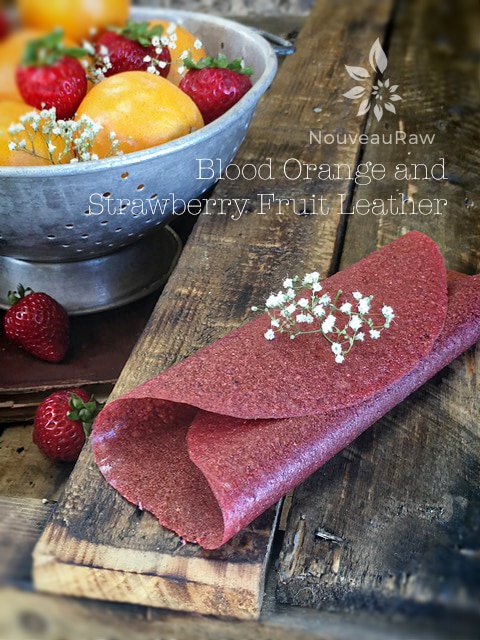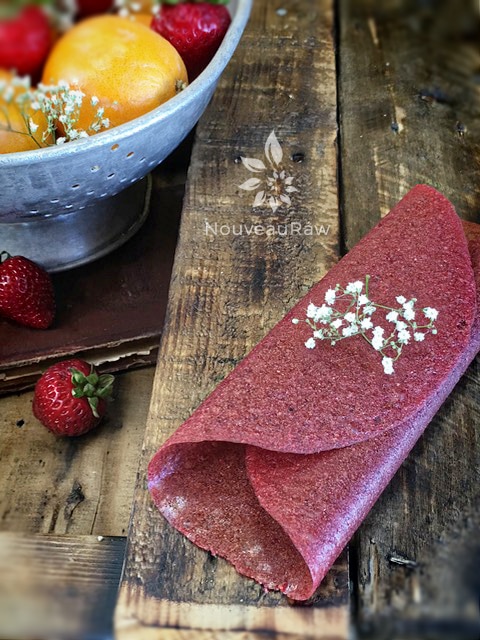Blood Orange and Strawberry Fruit Leather

 Add to favorites
Add to favorites
 ~ raw, vegan, gluten-free, nut-free ~
~ raw, vegan, gluten-free, nut-free ~
Last week I made a pass through Whole Foods in Portland and much to my delight I found blood oranges were in season. As I have been in deep development of fruit leathers this past month, I now look at produce in a whole new way.
What would blood oranges taste like in fruit leathers?! One way to find out…buy some and make some! This recipe has a very powerful and strong flavor combo.
I recommend segmenting the orange slices to avoid any bitter flavor from the orange membrane, but it isn’t necessary. It will depend on how ripe the orange is, and sometimes the membrane can be bit bitter.
When preparing raw food dishes, I can’t stress enough how important it is to taste test as you go. Every recipe has the potential of tasting a tad bit different based on the quality and ripeness of the ingredients used.
This strikingly beautiful fruit is one of the sweetest in the citrus family. They are juicy, sweet and slightly less acidic than regular oranges. They have a distinctive flavor, which hints of raspberry in addition to the rich orange flavor. The name comes from their extraordinary crimson red flesh. If you have never eaten a blood orange before, now is the time. You will be amazed not only by the taste but the vibrant beauty.
Ingredients:
1 1/2 cups puree
- 2 cups fresh organic strawberries
- 1 blood orange, peeled and segmented (see below)
- 1 vanilla bean pod
Preparation:
- Select RIPE or overly ripe strawberries that have reached a peak in color, texture, and flavor.
- Puree the fruit and vanilla bean pod, in the blender or food processor until smooth. Taste and sweeten more if needed. Keep in mind that flavors will intensify as they dehydrate. When adding a sweetener do so a little at a time, and reblend, tasting until it is at the desired taste. It is best to use a liquid type sweetener. Don’t use granulated sugar because it tends to change the texture.
- Spread the fruit puree on teflex sheets that come with your dehydrator. Pour the puree to create an even depth of 1/8 to 1/4 inch. If you don’t have teflex sheets for the trays, you can line your trays with plastic wrap or parchment paper. Do not use wax paper or aluminum foil.
- Lightly coat the food dehydrator plastic sheets or wrap with a cooking spray, I use coconut oil that comes in a spray.
- When spreading the puree on the liner, allow about an inch of space between the mixture and the outside edge. The fruit leather mixture will spread out as it dries, so it needs a little room to allow for this expansion.
- Be sure to spread the puree evenly on your drying tray. When spreading the puree mixture, try tilting and shaking the tray to help it distribute more evenly. Also, it is a good idea to rotate your trays throughout the drying period. This will help assure that the leathers dry evenly.
 Dehydrate the fruit leather at 145 degrees (F) for 1 hour, reduce temp to 115 degrees (F) and continue drying for about 16 (+/-) hours. The finished consistency should be pliable and easy to roll.
Dehydrate the fruit leather at 145 degrees (F) for 1 hour, reduce temp to 115 degrees (F) and continue drying for about 16 (+/-) hours. The finished consistency should be pliable and easy to roll.
- Check for dark spots on top of the fruit leather. If dark spots can be seen it is a sign that the fruit leather is not completely dry.
- Press down on the fruit leather with a finger. If no indentation is visible or if it is no longer tacky to the touch, the fruit leather is dry and can be removed from the dehydrator.
- Peel the leather from the dehydrator trays or parchment paper. If it peels away easily and holds its shape after peeling, it is dry. If it is still sticking or loses its shape after peeling, it needs further drying.
- Under-dried fruit leather will not keep; it will mold. Over-dried fruit leather will become hard and crack, although it will still be edible and will keep for a long time
- Storage: To store the finished fruit leather…
- Allow the leather to cool before wrapping up to avoid moisture from forming, thus giving it a breeding ground for molds.
- Roll them up and wrap them tightly with plastic wrap. Click (here) to see photos of how I wrap them.
- Place in an air-tight container, and store in a dry, dark place. (Light will cause the fruit leather to discolor.)
- The fruit leather will keep at room temperature for one month, or in a freezer for up to one year
Culinary Explanations:
- Why do I start the dehydrator at 145 degrees (F)? Click (here) to learn the reason behind this.
- When working with fresh ingredients, it is important to taste test as you build a recipe. Learn why (here).
- Don’t own a dehydrator? Learn how to use your oven (here). I do however truly believe that it is a worthwhile investment. Click (here) to learn what I use.
© AmieSue.com
Tags: Dairy Free, Dehydrated, Gluten Free, Nut Free, Refined Sugar Free, Soy Free, Vegan



 Add to favorites
Add to favorites
 ~ raw, vegan, gluten-free, nut-free ~
~ raw, vegan, gluten-free, nut-free ~ Dehydrate the fruit leather at 145 degrees (F) for 1 hour, reduce temp to 115 degrees (F) and continue drying for about 16 (+/-) hours. The finished consistency should be pliable and easy to roll.
Dehydrate the fruit leather at 145 degrees (F) for 1 hour, reduce temp to 115 degrees (F) and continue drying for about 16 (+/-) hours. The finished consistency should be pliable and easy to roll.
This looks great! Can’t wait to try it. When is the best time to slice the leather into those picture perfect strips? Before, after or in middle of dehydrating. Thanks!
Good morning Kimmi,
It is best to always cut the leather when it is done drying. amie sue